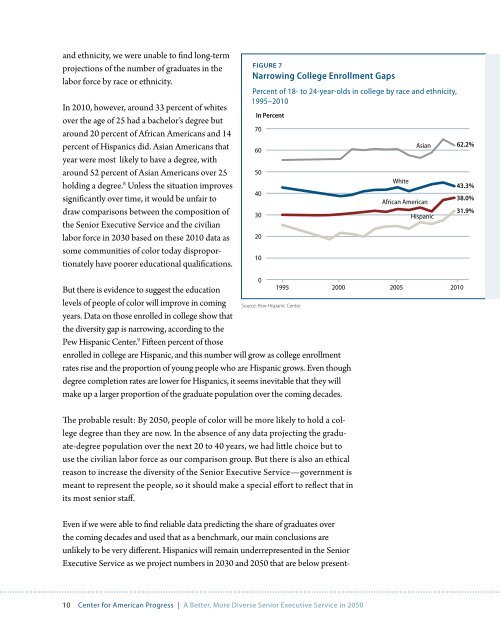A Better, More Diverse Senior Executive Service in 2050
A Better, More Diverse Senior Executive Service in 2050
A Better, More Diverse Senior Executive Service in 2050
You also want an ePaper? Increase the reach of your titles
YUMPU automatically turns print PDFs into web optimized ePapers that Google loves.
and ethnicity, we were unable to f<strong>in</strong>d long-termprojections of the number of graduates <strong>in</strong> thelabor force by race or ethnicity.In 2010, however, around 33 percent of whitesover the age of 25 had a bachelor’s degree butaround 20 percent of African Americans and 14percent of Hispanics did. Asian Americans thatyear were most likely to have a degree, witharound 52 percent of Asian Americans over 25hold<strong>in</strong>g a degree. 8 Unless the situation improvessignificantly over time, it would be unfair todraw comparisons between the composition ofthe <strong>Senior</strong> <strong>Executive</strong> <strong>Service</strong> and the civilianlabor force <strong>in</strong> 2030 based on these 2010 data assome communities of color today disproportionatelyhave poorer educational qualifications.Figure 7Narrow<strong>in</strong>g College Enrollment GapsPercent of 18- to 24-year-olds <strong>in</strong> college by race and ethnicity,1995–2010In Percent70605040302010WhiteAsianAfrican AmericanHispanic62.2%43.3%38.0%31.9%But there is evidence to suggest the educationlevels of people of color will improve <strong>in</strong> com<strong>in</strong>g Source: Pew Hispanic Center.years. Data on those enrolled <strong>in</strong> college show thatthe diversity gap is narrow<strong>in</strong>g, accord<strong>in</strong>g to thePew Hispanic Center. 9 Fifteen percent of thoseenrolled <strong>in</strong> college are Hispanic, and this number will grow as college enrollmentrates rise and the proportion of young people who are Hispanic grows. Even thoughdegree completion rates are lower for Hispanics, it seems <strong>in</strong>evitable that they willmake up a larger proportion of the graduate population over the com<strong>in</strong>g decades.The probable result: By <strong>2050</strong>, people of color will be more likely to hold a collegedegree than they are now. In the absence of any data project<strong>in</strong>g the graduate-degreepopulation over the next 20 to 40 years, we had little choice but touse the civilian labor force as our comparison group. But there is also an ethicalreason to <strong>in</strong>crease the diversity of the <strong>Senior</strong> <strong>Executive</strong> <strong>Service</strong>—government ismeant to represent the people, so it should make a special effort to reflect that <strong>in</strong>its most senior staff.Even if we were able to f<strong>in</strong>d reliable data predict<strong>in</strong>g the share of graduates overthe com<strong>in</strong>g decades and used that as a benchmark, our ma<strong>in</strong> conclusions areunlikely to be very different. Hispanics will rema<strong>in</strong> underrepresented <strong>in</strong> the <strong>Senior</strong><strong>Executive</strong> <strong>Service</strong> as we project numbers <strong>in</strong> 2030 and <strong>2050</strong> that are below present-01995 2000 2005 201010 Center for American Progress | A <strong>Better</strong>, <strong>More</strong> <strong>Diverse</strong> <strong>Senior</strong> <strong>Executive</strong> <strong>Service</strong> <strong>in</strong> <strong>2050</strong>













